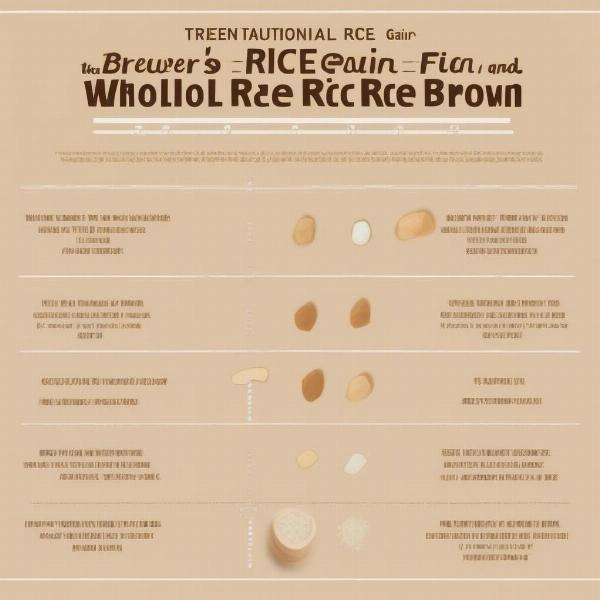Brewer’s rice is a common ingredient found in many commercial dog foods, and understanding its role in your dog’s diet is important. So, what is brewer’s rice in dog food? It’s a byproduct of the brewing process, essentially what’s left over after the sugars needed for fermentation have been extracted from rice. Unlike whole ground rice, brewer’s rice doesn’t contain the outer layers, making it lower in fiber and certain nutrients. This article will delve into the pros and cons of brewer’s rice, its nutritional value, and whether it’s a suitable ingredient for your furry friend.
Decoding Brewer’s Rice: Byproduct or Beneficial Ingredient?
Brewer’s rice is often perceived negatively due to its association with “byproducts.” However, this doesn’t automatically make it a bad ingredient. While it lacks the fiber and some nutrients found in whole ground rice, brewer’s rice is a readily available and affordable source of carbohydrates, which provide energy for your dog. This makes it a cost-effective filler ingredient for dog food manufacturers. However, the key is moderation. Too much brewer’s rice can lead to weight gain and offer limited nutritional benefits.
Nutritional Value of Brewer’s Rice in Dog Food
While not a nutritional powerhouse, brewer’s rice does contribute some nutrients to a dog’s diet. It’s a source of easily digestible carbohydrates, providing energy for daily activities. It also contains small amounts of protein and some B vitamins. However, it’s important to remember that these nutrients are present in lower concentrations compared to whole ground rice.
Is Brewer’s Rice Good or Bad for Dogs?
The question of whether brewer’s rice is good or bad for dogs is complex. It’s not inherently harmful and can be a part of a balanced diet. However, it shouldn’t be the primary ingredient. royal canin intestinal dog is a good example of food specially formulated for canine health. A good quality dog food will use brewer’s rice sparingly, balancing it with other nutrient-rich ingredients. Too much brewer’s rice can lead to weight gain and digestive issues, particularly in dogs prone to sensitivities.
Brewer’s Rice vs. Whole Grain Rice: What’s the Difference?
The main difference between brewer’s rice and whole grain rice lies in their processing. Brewer’s rice is a byproduct, stripped of the outer layers and germ, resulting in a lower fiber content. Whole grain rice, on the other hand, retains these components, providing more fiber and a wider range of nutrients. is rachael ray dog food healthy discusses the importance of healthy ingredients in dog food. For dogs with sensitive stomachs, whole grain rice is often a better choice due to its higher digestibility.
Choosing the Right Dog Food with Brewer’s Rice
When choosing dog food containing brewer’s rice, prioritize quality. Look for brands that list meat as the primary ingredient and use whole grains and vegetables alongside brewer’s rice. Avoid foods where brewer’s rice is the main component, indicating a filler-heavy formula. Consider your dog’s individual needs. If your dog has allergies or digestive issues, consult your veterinarian for guidance. is pure harmony a good dog food can offer some insights into choosing quality dog food.
 Comparing dog food ingredients
Comparing dog food ingredients
Conclusion
Brewer’s rice in dog food can be part of a balanced diet when used in moderation. It provides a source of carbohydrates for energy but lacks the full nutritional profile of whole grain rice. Choosing a high-quality dog food that prioritizes meat and whole grains alongside brewer’s rice is crucial for your dog’s health. Always consider your dog’s individual needs and consult your veterinarian if you have any concerns about brewer’s rice or other ingredients in their food.
FAQ
- Is brewer’s rice harmful to dogs? Brewer’s rice itself is not toxic to dogs, but excessive amounts can contribute to weight gain and digestive problems.
- What are the benefits of brewer’s rice in dog food? It provides a readily available and cost-effective source of carbohydrates for energy.
- Should I avoid dog food with brewer’s rice? Not necessarily. Look for foods where it’s used sparingly alongside other nutritious ingredients.
- What’s a better alternative to brewer’s rice? Whole grain rice offers more fiber and nutrients.
- How can I tell if my dog is reacting negatively to brewer’s rice? Look for signs of digestive upset, such as vomiting, diarrhea, or excessive gas.
- Can puppies eat food with brewer’s rice? Yes, but ensure the food is formulated for puppies and uses brewer’s rice in moderation.
- Is brewer’s rice the same as white rice? No. Brewer’s rice is a byproduct of the brewing process, while white rice is milled and polished.
ILM Dog is your trusted resource for expert dog care advice. We cover a range of topics from breed selection and health care to training, nutrition, grooming, and product reviews. Our goal is to provide practical and reliable information for dog owners worldwide. For more information on dog nutrition and choosing the best food for your furry friend, explore our website or contact us directly. Email: [email protected] Phone: +44 20-3965-8624 Visit ILM Dog for expert guidance on all aspects of dog care.